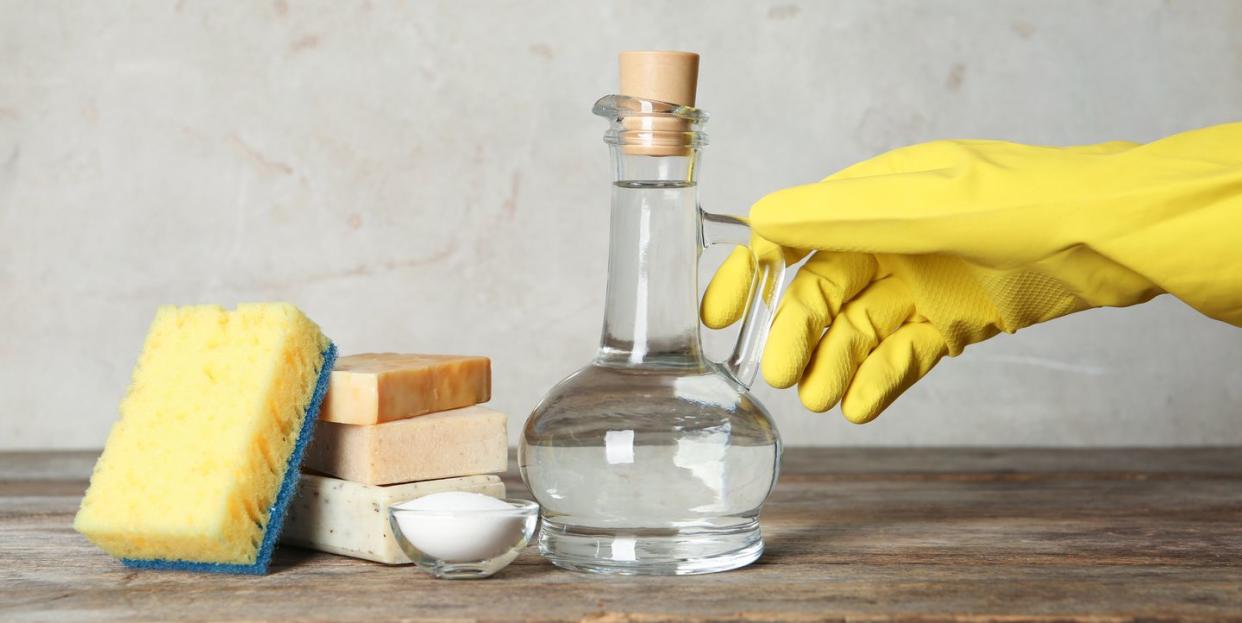You Shouldn't Swap Your Normal Cleaning Products For Vinegar Just Yet

Vinegar is somewhat of a liquid elixir, and its uses are literally endless. Not only do many varieties taste amazing on salads, chicken dishes, and snacks, but vinegar is often used in everything from laundry to household cleaning. Vinegar is also super cheap (and natural, if you tend to shop for chemical-free products) and something you probably have around the house or already in your pantry.
But before you go swapping all your Clorox wipes for a rag and bottle of vinegar, you should know that experts and the Environmental Protection Agency (EPA) have a few things to say about vinegar as a disinfectant agent. And if you really want to make sure your home and food stays germ-free, you'll wanna read up. Here's everything you need to know about using vinegar for cleaning and disinfecting your life.
So, is vinegar really a disinfectant?
The short answer is yes—but it's a little more complicated than that. “Vinegar does have disinfectant activity,” Alan Taege, MD, infectious disease expert at the Cleveland Clinic. “Vinegar is acetic acid, which has the ability to destroy bacteria and viruses." But, Dr. Taege notes, "many commercial disinfectants would likely be more effective." (More on that in a minute.)
The science is still a little bit scarce on vinegar's effectiveness as a disinfectant, but there have been a handful of studies that have shown vinegar has antibacterial properties, especially when it comes to killing bacteria on food during food prep. One small study showed that vinegar reductions or dressings can indeed have this effect (and reduce the presence of bacteria like Salmonella) when used for 15 minutes or more.
In one small study that looked at the efficacy of both chemical and natural cleaning products, 6 percent vinegar was found to be antimicrobial and decreased the presence of Staphylococcus aureus and E. coli—but not nearly as effectively as chemical products like Clorox and Lysol. And you need to allow at least a half hour of exposure. Another study found that after 30 minutes, a 6 percent acetic acid efficiently killed the bacteria M. tuberculosis. What's more, 10 percent malt vinegar could be useful in killing influenza viruses, a 2010 paper found.
While these results are promising, we need more research on what specific types of vinegar, and at what percent acidity, is effective at killing a substantial amount of germs. It's also important to note that vinegar is *not* on the list of the EPA's certified disinfectants. All in all, it's best to only use vinegar for disinfectant purposes in the context of food preperation—and not to clean germs off surfaces or, say, clean wounds or treat bodily infections *if* you can use a chemical cleaner instead.
But I've got nothing else! What type of vinegar would be the best disinfectant in this case?
“The most commonly used form would be white vinegar,” says Dr. Taege. This is because of white vinegar tends to be the most acidic, between 4 to 7 percent acetic acid, while cider and wine vinegars are usually closer to 5 to 6 percent acetic acid. But that doesn’t make other vinegars totally useless. “Others can work because they have acetic acid as a base as well,” he adds, but they may be less effective.
If you’re looking to make your own disinfecting solution at home (again, pros recommend going the chemical route if you can), combine vinegar with water in a 1:1 solution, according to the National Sanitation Foundation (NSF). Vinegar can be used on surfaces such as glass, windows, walls, cupboards, floors, sinks, stovetops and coffee makers. But it shouldn’t be used on surfaces like natural stone, waxed wood, cast iron or aluminum.
Also, a vinegar cleaning solution won’t cut it for surfaces with a high risk of food contamination, like cutting boards and the shelves/drawers if your refrigerator. For those, the NSF suggests using a bleach solution. It also notes that you should *never* combine vinegar with bleach or hydrogen peroxide, as it can create toxic vapors. Yikes.
What disinfectants should I use instead of vinegar?
You're better off using common commercial disinfectants, including Clorox, Lysol, Mr. Clean products, Purell disinfecting products (like the wipes), and ethanol (aka rubbing alcohol), studies show. For a complete list of the products that the EPA has registered as effective disinfectants and sterilizers for different types of bacteria and pathogens, head here.
In addition, the Centers for Disease Control and Prevention (CDC) states that diluted household bleach solutions and alcohol solutions with at least 70 percent alcohol are effective in combatting viruses.
The bottom line: While it may not hurt to try out a vinegar solution to kill germs, chemical solutions have been studied more in depth and proven to be much more effective at killing different types of bacteria and viruses.
You Might Also Like

